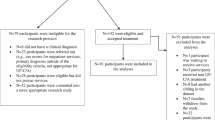Abstract
We studied 1,397 youth undergoing treatment in a multi-program, multiservice agency serving vulnerable youth in both community and residential settings, testing for associations between four indicators of youth’s emotional distress dispositions and the frequency of crisis events demanding a crisis response within the first 6 months of youth’s participation in a treatment program. We addressed individual and program-level research aims employing a two-level hierarchical model considering both individual and program levels of influence. Results indicated the presence of strong associations for youth’s anger control and frustration management issues, a weaker association for anxiety/anxious disposition, and no significant association for irritability/poor self-control problems. Aggregate emotional distress differences for youth in school, probation, wraparound, residential, or community mental health programming contributed little beyond emotional distress differences among individual youth. Consistent with psychological theory, clinically measured emotional distress dispositions prompt significant behavioral disruption for youth in residential placements as well as in community settings, and they can be detected early in treatment for guiding remedial efforts.
Similar content being viewed by others
References
Andersen, R. M. (1995). Revisiting the behavioral model and access to medical care: Does it matter? Journal of Health and Social Behavior, 36(1), 1–10.
Breslow, R. E., Erickson, B. J., & Cavanaugh, K. C. (2000). The psychiatric emergency service: Where we’ve been and where we’re going. The Psychiatric Quarterly, 71(2), 101–121.
Curie, C. G. (2005). SAMHSA’s commitment to eliminating the use of seclusion and restraint. Psychiatric Services, 56(9), 1139–1140.
Dolan, M. A., & Fein, J. A. (2011). Pediatric and adolescent mental health emergencies in the emergency medical services system. Pediatrics, 127(5), e1356–e1366. doi:10.1542/peds.2011-0522.
Edelsohn, G. A., Braitman, L. E., Rabinovich, H., Sheves, P., & Melendez, A. (2003). Predictors of urgency in a pediatric psychiatric emergency service. Journal of the American Academy of Child and Adolescent Psychiatry, 42(10), 1197–1202. doi:10.1097/00004583-200310000-00010.
Gould, M. S., Greenberg, T., Velting, D. M., & Shaffer, D. (2003). Youth suicide risk and preventive interventions: A review of the past 10 years. Journal of the American Academy of Child and Adolescent Psychiatry, 42(4), 386–405. doi:10.1097/01.CHI.0000046821.95464.CF.
Green, J. G., McLaughlin, K. A., Alegría, M., Costello, E. J., Gruber, M. J., Hoagwood, K., & Kessler, R. C. (2013). School mental health resources and adolescent mental health service use. Journal of the American Academy of Child and Adolescent Psychiatry, 52(5), 501–510. doi:10.1016/j.jaac.2013.03.002.
Greene, R. W., Ablon, J. S., & Goring, J. C. (2003). A transactional model of oppositional behavior. Journal of Psychosomatic Research, 55(1), 67–75. doi:10.1016/S0022-3999(02)00585-8.
Greene, R. W., Ablon, J. S., & Martin, A. (2006). Use of collaborative problem solving to reduce seclusion and restraint in child and adolescent inpatient units. Psychiatric Services, 57(5), 5–7.
Gullone, E., & Taffe, J. (2012). The emotion regulation questionnaire for children and adolescents (ERQ-CA): A psychometric evaluation. Psychological Assessment, 24(2), 409–417. doi:10.1037/a0025777.
Harpaz-Rotem, I., Leslie, D. L., Martin, A., & Rosenheck, R. A. (2005). Changes in child and adolescent inpatient psychiatric admission diagnoses between 1995 and 2000. Social Psychiatry and Psychiatric Epidemiology, 40(8), 642–647. doi:10.1007/s00127-005-0923-0.
Hodges, K., Kline, J., Stern, L., Cytryn, L., & McKnew, D. (1982). The development of a child assessment interview for research and clinical use. Journal of Abnormal Child Psychology, 10(2), 173–189.
Lyons, J. S., Kisiel, C. L., Dulcan, M., Cohen, R., & Chesler, P. (1997). Crisis assessment and psychiatric hospitalization of children and adolescents in state custody. Journal of Child and Family Studies, 6(3), 311–320.
Lyons, J. S., Rawal, P., Yeh, I., Leon, S. C., & Tracy, P. (2002). Use of measurement audit in outcomes management. The Journal of Behavioral Health Services and Research, 29(1), 75–80.
Mahajan, P., Alpern, E. R., Grupp-Phelan, J., Chamberlain, J., Dong, L., Holubkov, R., & Foltin, G. L. (2009). Epidemiology of psychiatric-related visits to emergency departments in a multicenter collaborative research pediatric network. Pediatric Emergency Care, 25(11), 715–720. doi:10.1097/PEC.0b013e3181bec82f.
Martin, A., Krieg, H., Esposito, F., Stubbe, D., & Cardona, L. (2008). Reduction of restraint and seclusion through collaborative problem solving: A five-year prospective inpatient study. Psychiatric Services (Washington, DC), 59(12), 1406–1412. doi:10.1176/appi.ps.59.12.1406.
Masters, K. J., & Bellonci, C. (2002). Practice parameter for the prevention and management of aggressive behavior in child and adolescent psychiatric institutions, with special reference to seclusion and restraint. Journal of the American Academy of Child and Adolescent Psychiatry, 41(2), 4S–25S. doi:10.1097/00004583-200202001-00002.
Rotheram-Borus, M. J. (1993). Suicidal behavior and risk factors among runaway youths. The American Journal of Psychiatry, 150(1), 103–107.
SAMHSA. (2009). Practice guidelines: Core elements in responding to mental health crises (pp. 1–14). HHS Pub No. SMA-09-4427. Rockville, MD.
Spirito, A., & Esposito-Smythers, C. (2006). Attempted and completed suicide in adolescence. Annual Review of Clinical Psychology, 2, 237–266. doi:10.1146/annurev.clinpsy.2.022305.095323.
Thompson, S. J., & Pollio, D. E. (2006). Adolescent runaway episodes: Application of an estrangement model of recidivism. Social Work Research, 30(4), 245–251.
Weinberg, A., & Klonsky, E. D. (2009). Measurement of emotion dysregulation in adolescents. Psychological Assessment, 21(4), 616–621. doi:10.1037/a0016669.
Author information
Authors and Affiliations
Corresponding author
Rights and permissions
About this article
Cite this article
Cordell, K., Snowden, L. Emotional Distress Dispositions and Crisis Intervention for Children Treated for Mental Illness. J Child Fam Stud 24, 2699–2709 (2015). https://doi.org/10.1007/s10826-014-0072-8
Published:
Issue Date:
DOI: https://doi.org/10.1007/s10826-014-0072-8




